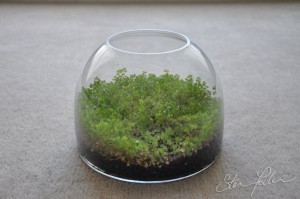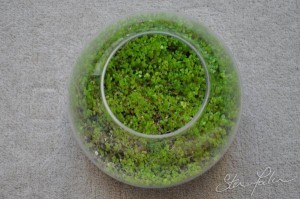Hart's Tongue Fern Terrarium
Depending on your age you might just cringe at the thought of going down this gardening path but bear with me as I think it has merit. If you’re in the younger Gen Y category then you’ll probably be discovering terrariums for the first time.

I met a very talented glass blower, Sarah Mulligan, in Victoria, Canada and amongst her work was a terrarium. It was very cute and got me thinking about reviving this look. When I returned to Sydney I went hunting for some unusual glass containers. This first one came from Kmart and cost me $15 I think. The others pictured here came from a furniture store and a florists. There are plenty of inexpensive objects out there. Just be very careful if you find yourself gravitating to aquariums or large bottles. The 70s were pretty scarey and you really don’t want to go there again!
Next you need to select your plants. A terrarium has limited air movement and elevated humidity. Ferns and many indoor plants will thrive in this situation. You can usually get small specimens cheaply and create a beautiful planted terrarium instantly. Keep in mind though that many of these plants will outgrow the limited space in your terrarium so you’ll need to trim them or change the plants over in the future.
As a terrarium has no drainage holes you need to be very careful you don’t overwater. Old style terrariums (corked bottles and aquariums) were closed environments and rarely needed watering after the initial setup. The terrariums pictured here are not sealed off so moisture is still lost through evaporation and transpiration. Regular watering is required. The frequency and quantity will vary with each setup so you’ll need to play around with it to get it right. These terrariums get watered every 1-2 weeks in winter and 1-2 times a week in summer.

Baby's Tears (Soleirolia soleirolii)

Baby's Tears (Soleirolia soleirolii)

- Overgrown baby’s tears terrarium
My baby’s tears terrarium requires pruning every couple of months. Pictured here is one time when I let it go too long! Can you imagine how often it would need trimming if I was fertilising it all the time? Enough said on the fertilising topic.
With a bit of thought you can easily create a terrarium which requires little care and looks great. All you need is an interesting container and to start planting!
PS Don’t forget to check out The Plant Addict Shop while you’re here.
You’ll find great gift ideas for garden lovers and fellow plant addicts!